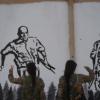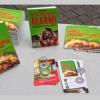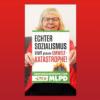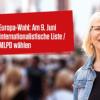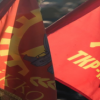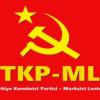
Support the Self-Organization of the Armenian People! Give voice to the children of genocide!
Today, an opportunity has emerged for all peoples to live together in the autonomous territories of North-East Syria in the Middle East. Like other peoples, Armenians fought against ISIS reaction in these lands and defended their homes. Today, as the children of the genocide, a military battalion and a social council is organizing both its military power and its people. These lands, which guarantee peoples’ common life, are under threat from many states, especially the Turkish state. We call on all those who support freedom, peace and common life, especially our Armenian people living in the diaspora, to support our solidarity campaign with the Armenian people, who defend their homeland in the autonomous territories of North-East Syria and are forming the Armenian People’s Assembly.
The history of the Armenian people in Syria
Approximately 1 million Armenians were exiled to Syrian lands by the fascist Young Turk regime, forerunner of Kemalism and the republic of Turkey, during the genocide initiated by the Ottoman state in 1915. Armenians who survived the Genocide have struggled to survive, and found the chance and opportunity to to live in Syria. A small part of the Armenians were able to protect themselves with their own culture, language and religion, but the majority were assimilated into Kurdish or Arab Muslim families. The Armenians are afraid that the Assad administration will come again. The Armenian people, who are very afraid of the Assad regime, have at the same time been hesitant to approach the democratic rule begun by the Kurdish people in the Rojava revolution. They have always stayed at a certain distance from the Kurdish people.
Today, the number of Armenians in Syria is not known clearly, but it is estimated that 40-50 thousand remain.
The meaning of self-defence in Rojava (YPG-Kurds-, SDF -Arab-, Assyrian/Syriac military assemblies) and self-defence of the Armenian people
The self-defence organizations that started as a result of the pressures of the Syrian Regime in 2004 entered a new phase in 2011, and led to the formation of the YPG/YPJ. In the following years, the liberation of the North-East Syrian territories from ISIS reaction, and the peoples’ participation in the war, led to the collective defence of their shared homeland. With the defeat of the Turkish-backed ISIS by Arab, Assyrian, Syriac, Armenian, Turkmen and other peoples, especially the Kurdish people, a revolution was made in North-East Syria and an autonomous administration was achieved. Each people carry out their military assemblies and social organising in the context of their own self-defence.
After the Rojava revolution, the Nubar Ozanyan military battalion and the Armenian Social Council were established by Armenians living in Rojava. The Nubar Ozanyan Battalion, the self-defence battalion of the Armenian people, is organised as part of the Syrian Democratic Forces (SDF), which is the umbrella self-defence of the Syrian Democratic Council and Autonomous Administration. While preparing for the defence of the country in the military field against the invasion threats of the Turkish Republic and its gangs, they are trying to protect their identity by learning the history, languages and cultures of the genocide. Christian and Islamized Armenians claim their identity under the same roof, defending the Rojava revolution as a people against the imposition of a second genocide, and developing life together with other peoples. Special attention is paid to women’s struggle for freedom: a special committee on women’s studies has been formed under the roof of the Social Council; and the Nubar Ozanyan Women’s Battalion is being built for the participation of women in self-defence.
Today
The attacks of the fascist Turkish state against Karabakh, alongside its invasion and threats against Rojava, compel the Armenian people living in the territory of the autonomous administration of North East Syria to defend themselves all the more. Self-defence is an absolute necessity in order not to experience the repetition of the genocide that took place 106 years ago, to preserve the unity of the peoples formed in the region, and to re-learn their forgotten culture and language. The occupation in Nagorno-Karabakh offered great lessons to Armenians living in Syria: the further development of self-defence, and the greater strengthening of their associations with other peoples. In this sense, Armenians who are one among many different peoples, have turned their attention to building their own military and civil institutions. With stronger Armenian institutions, and stronger self-defence, it becomes possible to live with other peoples.
What are the Campaign’s Aims?
- The Armenian people’s struggles are not independent from the Rojava revolution. Armenians living here will also strengthen this revolution from their own fronts in order to embrace and strengthen the revolution. The campaign’s role is to support and raise awareness about this crucial work.
- The Nubar Ozanyan Battalion is the self-defence force that defends the Rojava revolution and its own people militarily. In this sense, it stands on the front against Turkish fascism and the gangs it supports. The battalion needs the political, military and financial support of Armenians and their allies around the world.
- The Armenian Social Council is the civilian organization of the Armenian people of North-East Syria. Those Armenians who lived as Muslims and became Arabic or Kurdish after the Genocide, must learn their mother tongue and know its history, and the Council has an important place in bringing back a living culture. It has the understanding, oversight and ability to organize both Christian and Muslim Armenian people under a single roof. It aims to organize its own people and expand the gains of Rojava revolution. This is the perspective of existence and struggle. In this sense, it will strengthen both self-defence and democratic-cultural gains. In order to do to implement these social projects the Council needs international support from Armenian and other civil society organisations and actors.


